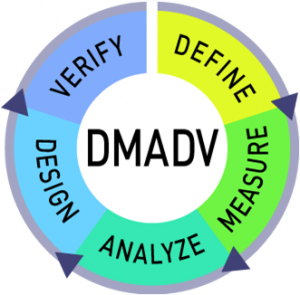DMADV is a Six Sigma framework that focuses primarily on the development of a new service, product or process as opposed to improving a previously existing one. This approach – Define, Measure, Analyze, Design, Verify – is especially useful when implementing new strategies and initiatives because of its basis in data, early identification of success and thorough analysis.
The DMADV methodology should be applied:
- when a non-existent product or process needs to be developed at a company and…
- when an existing process or product already exists but still needs to meet a Six Sigma level or customer specification.
Let’s examine the five major phases of DMADV more closely.
 Define
Define
The goals of the first phase are to identify the purpose of the project, process or service, to identify and then set realistic and measurable goals as seen from the perspectives of the organization and the stakeholder(s), to create the schedule and guidelines for the review and to identify and assess potential risks. A clear definition of the project is established during this step, and every strategy and goal must be aligned with the expectations of the company and the customers.
Measurement
Next comes measuring the factors that are critical to quality, or CTQs. Steps taken should include: defining requirements and market segments, identifying the critical design parameters, designing scorecards that will evaluate the design components more important to the quality, reassessing risk and assessing the production process capability and product capability. Once the values for these factors are known, then an effective approach can be taken to start the production process. It is important here to determine which metrics are critical to the stakeholder and to translate the customer requirements into clear project goals.
Analysis
Actions taken during this phase will include: developing design alternatives, identifying the optimal combination of requirements to achieve value within constraints, developing conceptual designs, evaluating then selecting the best components, then developing the best possible design. It is during this stage that an estimate of the total life cycle cost of the design is determined. After thoroughly exploring the different design alternatives, what is the best design option available for meeting the goals?
Design
This stage of DMADV includes both a detailed and high level design for the selected alternative. The elements of the design are prioritized and from there a high level design is developed. Once this step is complete, a more detailed model will be prototyped in order to identify where errors may occur and to make necessary modifications.
You may also enjoy: Close Encounters of the Six Sigma Kind: The Career of Director Steven Spielberg
Verify
In the final phase, the team validates that the design is acceptable to all stakeholders. Will the design be effective in the real world? Several pilot and production runs will be necessary to ensure that the quality is the highest possible. Here, expectations will be confirmed, deployment will be expanded and all lessons learned will be documented. The Verify step also includes a plan to transition the product or service to a routine operation and to ensure that this change is sustainable.
For any DMADV project, there may be more emphasis on certain components of the approach over others, though the goal remains the same: to address an identified issue and produce desired results in a way that can be maintained through normal operations.


